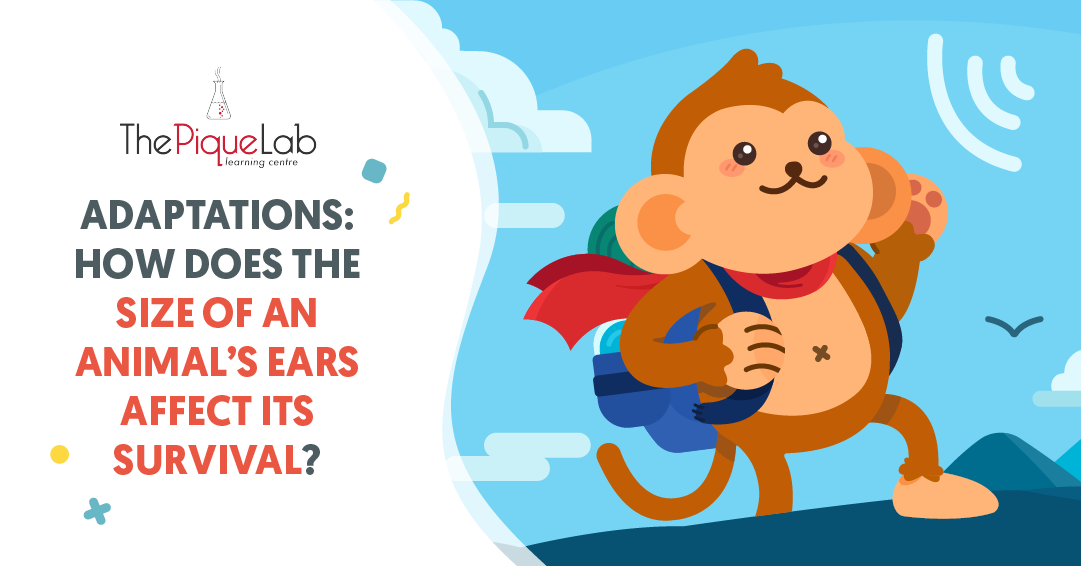I am sure everyone has searched for pictures of cute animals before! For myself, I will look up pictures of the snow fox and desert fox to show my P6 students when I teach them the topic of Adaptations.
Snow Fox (Left) and Desert Fox (Right)
We can observe that the snow fox has much smaller ears than the desert fox, as shown above.
Now for the golden question, what is the reason behind the different-sized ears?
Is it by chance? Or is there a practical purpose for having different-sized ears?
Before we explain the reason for the different-sized ears of the snow fox and the desert fox, let’s have a closer look at this question from the 2019 P6 SA1 Catholic High School Examination Paper and discuss the concepts tested.
Read Also:
Let’s Take A Look At This Question
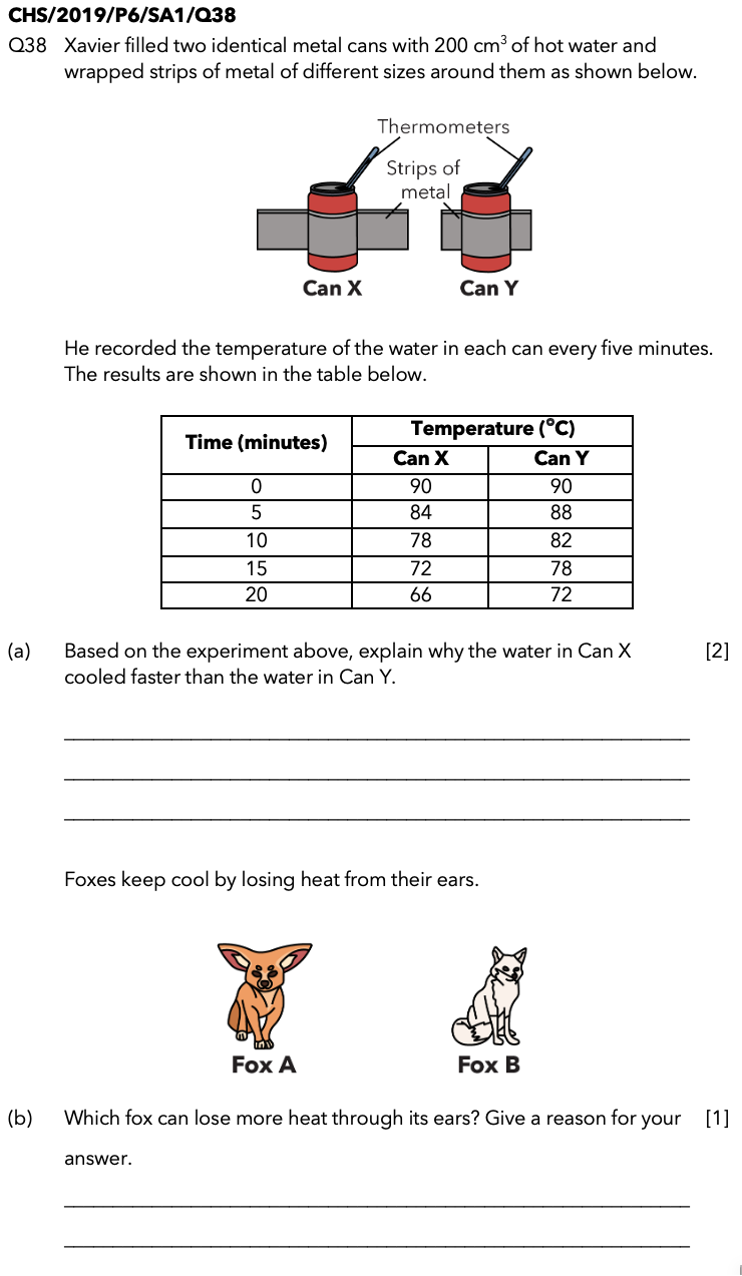
Source: Catholic High School – 2019 P6 SA1 Examination Paper [Q38]
Thought Process
For questions involving an experiment set-up like the one above, I always advise my students to do the following:
- Find the changed variable.
- Find the measured variable.
- Find the variables that were kept constant.
💡 Identifying the changed variable and measured variable from the experiment allows students to identify the aim of the experiment.
Identifying the constant variables allows students to know what has already been kept the same in the experiment to ensure a fair test.
“How do we know what is the changed variable?”

What is the difference between the two set-ups? It is the size of the strip of metal wrapped around each can, as indicated in the question (see below).
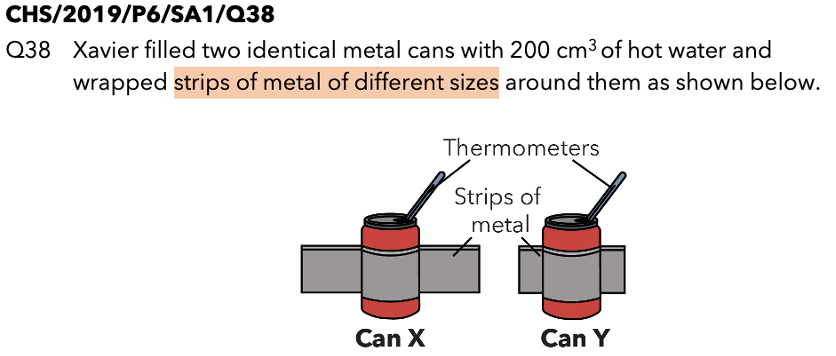
Here comes the next important question:
“How do we know what is the measured variable?”

So what is being observed/recorded in the experiment? It is the rate of decrease of the temperature of the water inside each can (see below).
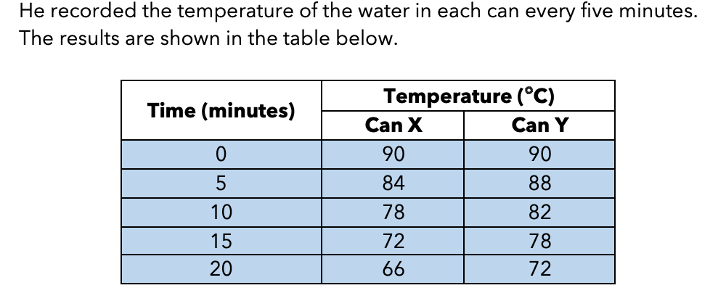
Now that we have identified the changed variable and measured variable, what is the aim of the experiment?
The aim is to find out how the size of the strip of metal affects the rate of decrease of the temperature of the water inside each can.
The last important question:
“What are the constant variables?”
Since the question specified that the metal cans are identical and 200 cm3 of hot water at 90 0C was poured into each can (see below), the type of can, the volume and initial temperature of the water inside each can should be the constant variables.
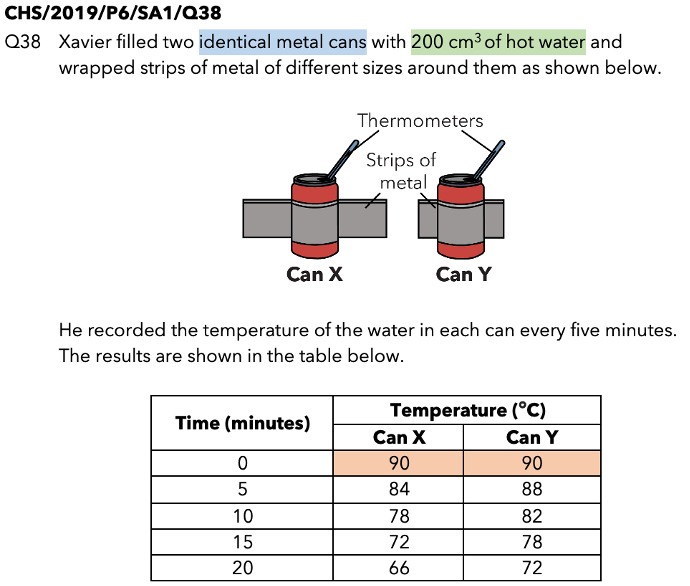
A summary of the experiment set-up so far:

Let’s Analyse Part (A)
Why did the water in Can X cool faster than the water in Can Y?
Many students will share that since the cans are labelled differently as X and Y, this means that the cans are made of different materials, where Can X is a better conductor of heat than Can Y.
Thus, Can X will conduct heat from the hot water to the cooler surrounding air at a faster rate, causing the water in Can X to cool faster.
Do you agree with the above explanation?
As reasonable as it sounds, if you refer to the summary table above, you will recall that we have identified the type of cans as the constant variable in this experiment.
Since Cans X and Y are identical, is it possible that Can X is a better conductor of heat than Can Y?
Impossible. The above explanation is definitely wrong!
🫙 Learning Point: As seen from the common mistake above, it is important to identify the constant variables in an experiment so that students will not wrongly identify the constant variable as a changed variable instead.
In that case, what is the reason why the water in Can X cooled faster than Can Y?
It should be due to the changed variable, which is the size of the strip of metal wrapped around the cans as seen from the summary table above.
Formulating Your Answer For Part (A)
What do we notice about the size of the strip of metal wrapped around Can X? The strip of metal is longer.
What is the science concept that we link to when we are comparing the length of the strip of metal? (Exposed) surface area!
Many students will write the following answer:
“The hot water in Can X cools faster as there is a larger surface area of the metal STRIP in contact with metal CAN X, causing the hot water to lose heat faster.”
Do you spot any mistakes with the above answer?
I have spotted 2 mistakes so let me discuss them. See if you manage to spot them too!
❌ Mistake 1: Larger surface area of the metal strip in contact with metal Can X ❌
The answer above mentions that there is a larger surface area of the metal strip in contact with metal Can X. Is this true?
Let us highlight the surface area of the metal STRIPS in contact with the metal CANS in green below for better visualisation.

For the areas highlighted in green on Cans X and Y, are they of the same size or different sizes? They are of the same size.
So is it true that the “surface area of the metal strip in contact with metal Can X is larger”? No!
Instead, it should be the “exposed surface area of the metal strip in contact with the cooler surrounding air (highlighted in blue below)” that is larger for Can X.
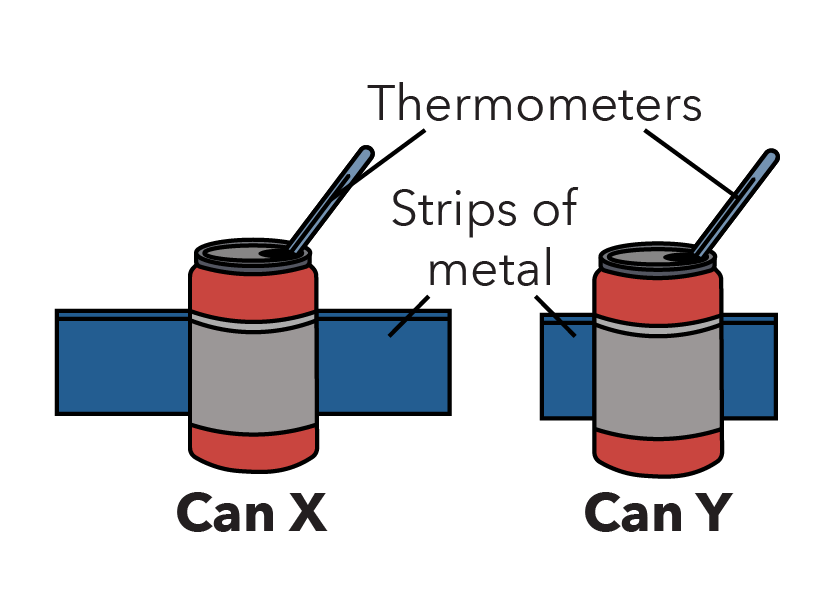
Now that we have identified the first mistake, let us rectify the original answer in red:
“The hot water in Can X cools faster as there is a larger exposed surface area of the metal strip in contact with the cooler surrounding air, causing the hot water to lose heat faster.”
❌ Mistake 2: Hot water to lose heat faster ❌
What’s wrong with the above phrase? Isn’t it true that the hot water in Can X will lose heat faster?
The issue is that the answer is incomplete.
When explaining questions on Heat, students must remember to specify “… lose heat to …” or “… gain heat from …”. If the “to” or “from” are missing in the answers, students will get their marks deducted.
So where will the hot water eventually lose heat to? The hot water will eventually lose heat to the cooler surrounding air.
Now that the second mistake has been identified, let us write out the final answer:
Suggested Answer For Part (A)
The hot water in Can X cools faster as there is a larger exposed surface area of the metal strip in contact with the cooler surrounding air, causing the hot water to lose heat faster to the cooler surrounding air.
Let’s Analyse Part (B)
Which fox can lose more heat through its ears? Give a reason for your answer.
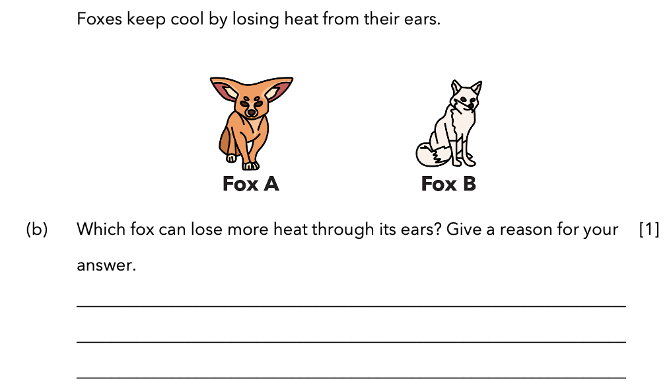
Source: Catholic High School – 2019 P6 SA1 Examination Paper [Q38]

In part (a), the strips of metal have different sizes, just like how the size of the ears for foxes A and B are different in part (b) of the question.
Thus, the set-ups in part (a) are models to explain the difference in the rate of heat loss in foxes A and B in part (b).
Recall the metal strips that we highlighted in blue previously (refer to the picture below).

Which part of the foxes do you think the metal strips highlighted in blue above represent? Since those sections of metal strips have different sizes and were in contact with the surrounding air, they represent the different sizes of ears that are in contact with the surrounding air.
Since we are required to find the fox that lost more heat through its ears, do we look for the fox that lost heat faster or slower through its ears? It must be faster!
As we have understood from part (a) that the hot water in Can X lost heat faster, where the metal strip around Can X is longer, we should also understand that the fox with larger ears should lose more heat/lose heat faster through its ears.
Which is the fox with larger ears? It is Fox A.
Following the answer for part (a):
The hot water in Can X cools faster as there is a larger exposed surface area of the metal strip in contact with the cooler surrounding air, causing the hot water to lose heat faster to the cooler surrounding air.
We can now craft a similar answer for part (b):
Suggested Answer For Part (B)
Fox A. Fox A has larger ears. Thus, there is a larger exposed surface area of its body in contact with the cooler surrounding air, causing Fox A’s body to lose heat faster to the cooler surrounding air.
Food For Thought
Now that we have answered both parts (a) and (b) of the question, let us answer the golden question posted at the start of the blog post:
“Is there a practical purpose for having different-sized ears for the desert fox and snow fox?”
The answer is yes!
Desert Fox
Since the desert fox has larger ears than the snow fox, the desert fox is like Fox A in the question (see the diagram below).
So why should the desert fox lose heat faster to the surrounding air, like Fox A?

Think about the desert environment that the desert fox stays in, is it very hot or cold in the day? It is very hot.
When the desert fox loses heat faster to the surrounding air, does it keep the desert fox cool or warm? It keeps the desert fox cool.
And does that help the desert fox to survive better in the hot desert environment? Definitely!
Snow Fox
Since the snow fox has smaller ears, it is like Fox B in the question.
So why should the snow fox lose heat slower to the surrounding air, like Fox B?
Think about the cold environment that the snow fox stays in. If the snow fox loses heat slower to the surrounding air, does it keep the snow fox cool or warm? It keeps the snow fox warm.
And does that help the snow fox to survive better in the cold snowy environment? Definitely!
Moving Forward
I hope you have enjoyed reading this article and that this article has helped you gain a better understanding of:
- What to do when you see an experiment-centric question.
- Keywords required to explain Heat questions.
- Why the desert fox and snow fox have different-sized ears.
Stay tuned for our new articles on how to tackle other Science questions!

If you like our methodology, we've some upcoming workshops:

